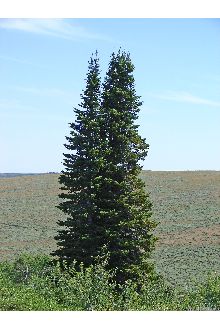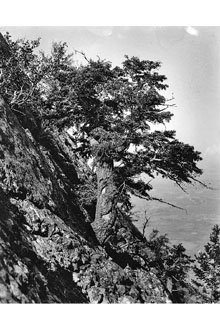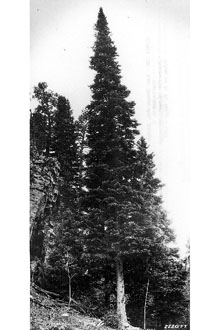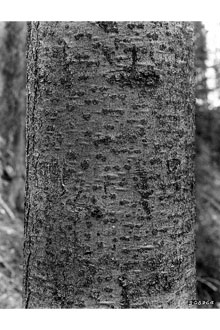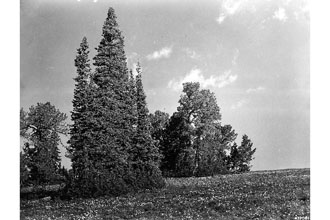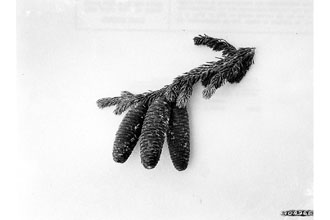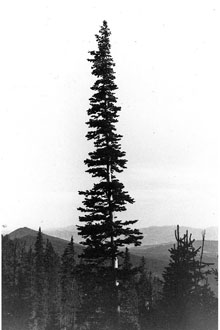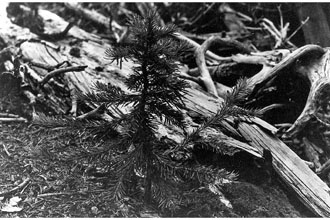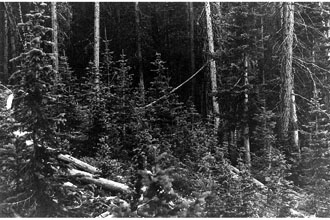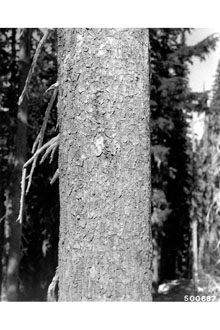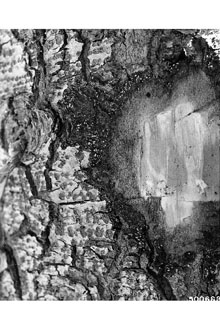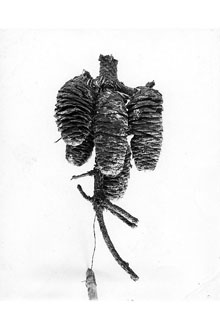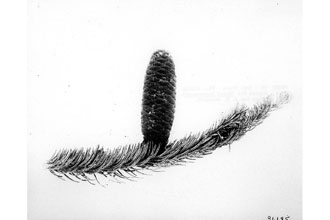Subalpine Fir
Scientific Name: Abies lasiocarpa (Hook.) Nutt.
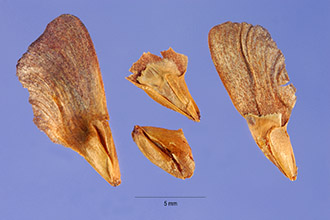
| General Information | |
|---|---|
| Usda Symbol | ABLA |
| Group | Gymnosperm |
| Life Cycle | Perennial |
| Growth Habits | Tree |
| Native Locations | ABLA |
Plant Guide
Uses
The wood is white, soft, brittle, and quick to decay, used for rough construction and boxes, doors, frames, poles, and fuel. Small trees are extensively used for Christmas trees. Subalpine fir is a forest pioneer on severe and disturbed sites. By providing cover, it assists in rehabilitating the landscape and protecting watersheds. Subalpine fir grows in forests that occupy the highest water yield areas in much of the western United States and are thus highly significant in water management and conservation. Native Americans used pitch and bark preparations for wounds and the wood, bark, and boughs for roof shingles, baskets and bedding. The pitch was also used to coat canoe seams and rubbed on bowstrings as a sealant and protectant.
Status
Please consult the PLANTS Web site and your State Department of Natural Resources for this plant’s current status, such as, state noxious status and wetland indicator values.
Description
General: Pine Family (Pinaceae). Native, evergreen trees growing to 20 meters tall with a sharp, spire-like crown, the upper several feet often less than 30 cm in diameter, the plants often reduced to a prostrate shrub on exposed sites near timberline. Bark is smooth, grayish-white, with resin blisters, becoming furrowed only when the tree approaches a foot in diameter (or var. arizonica, see below, with a softer, corky trunk); branches with bark splitting to reveal a reddish-brown layer; leaf scars with periderm red (or tan in var. arizonica). Needles are 1.8-3 cm long, flattened, grooved and bluish-green waxy on the upper surface, 1-ranked and tending to turn upward so that the foliage of a particular branch appears flattened and as though no leaves were attached to the lower sides of the twigs; resin canals median, located between the upper and lower epidermis. Seed cones are 6-12 cm long, 2-4 cm wide, dark purple, erect and only on the uppermost branches. The common name refers to the distribution of the species in the subalpine zone. From Earle, C.J. 2000 @ Gymnosperm Database Variation within the species: Taxonomy of the species is not settled. Abies bifolia A. Murr. may be treated within A. lasiocarpa or as a separate species (evidence summarized by Hunt 1993). A southern population system (Arizona, New Mexico, Colorado) is sometimes recognized as A. lasiocarpa var. arizonica (Merriam) Lemmon (corkbark fir), or it may be identified as part of A. bifolia. Abies lasiocarpa in the broad sense is distinguished from A. balsamea by 4-5 stomatal rows on the upper surface at midleaf (vs. mostly 7 rows in A. balsamea).
Distribution
Subalpine fir is widespread in western North America, from southeastern Alaska, Yukon, and Mackenzie south to California, in the Rocky Mountains to northeastern Arizona and New Mexico. For current distribution, please consult the Plant Profile page for this species on the PLANTS Web site.
Adaptation
Subalpine fir grows in subalpine coniferous forests, 600-3600 meters, up to timberline, often associated with Douglas fir, Engelmann spruce, and blue spruce. It is restricted to cold, humid habitats because of low tolerance to high temperatures. Cool summers, cold winters, and deep winter snowpacks are more important than total precipitation in differentiating where subalpine fir grows in relation to other species.
Establishment
Trees of subalpine fir may begin to produce cones when 20 years old, but under closed-forest conditions, seed production is not significant until trees are older, Corkbark fir does not begin to bear cones until about 50 years old, Maximum seed production occurs in dominant trees 150-200 years old, Germination and early survival are generally best on exposed mineral soil and moist humus, but a wide variety of other seedbed types also provide adequate conditions, Spring planting is most successful, Use soil moisture sensors to measure the soil moisture of Subalpine Fir., Subalpine fir invades and establishes on open, severe or disturbed sites near timberline because of its ability to establish a root system under conditions too severe for its less hardy associates and its ability to reproduce by layering, Subalpine fir is relatively slow growing, Seedlings average less than 38 cm in height after 15 years in the open, Heart rot is a severe problem, and many trees die or are complete culls at an early age, Of those reaching maturity, trees 25-51 cm in diameter are often 150-200 years old, and trees older than 250 years are not uncommon, Some trees in Olympic National Park, Washington, have been determined to be over 400 years old (by ring count),
Management
Periodic thinning increases the yield and size of individual trees, but the fir component of subalpine spruce-fir stands is likely to be greatly reduced by repeated thinning, so that the stand at the time of final harvest will be almost pure Spruce. In the Cascades, the European balsam woolly adelgid has caused significant mortality to subalpine fir, virtually eliminating it from some stands in Oregon and southern Washington. Windthrow is a common problem in subalpine fir, presumably because of its relatively shallow root system. Pruning should be kept to a minimum, for when older branches are removed, new growth seldom develops and, consequently, the trees become ragged and unkempt. Cultivars, Improved and Selected Materials (and area of origin) Available through most nurseries. Horticultural and ornamental cultures have been recognized, including the following: A. lasiocarpa cv. beissneri – a dwarf tree bearing distorted branches and twisted needles. A. lasiocarpa cv. caerulescens – a normal-sized tree with especially intensive bluish needles. A. lasiocarpa cv. compacta – a dwarf tree of compact habit.
References
Earle, C.J. 2000. Gymnosperm database-Abies lasiocarpa. 29nov2000. <http://www.geocities.com/~earlecj/pi/ab/lasiocarpa. htm> Foiles, M.W., R.T. Graham, & D.F. Olson, Jr. 1990. Abies lasiocarpa. Pp. 52-59, IN: R.M. Burns and B.H. Honkala. Silvics of North America. Volume 1. Conifers. USDA, Forest Service Agric. Handbook 654, Washington, D.C. <http://willow.ncfes.umn.edu/silvics_manual/Table_of_contents.htm> Hunt, R.S. 1993. Abies. Pp. 354-362, in Flora of North America, North of Mexico. Vol. 2, Pteridophytes and Gymnosperms. Oxford Univ. Press, New York, New York. <http://hua.huh.harvard.edu/cgi-bin/Flora/flora.pl?FLORA_ID=12395> Leadem, C.L. 1988. Dormancy and vigour of Abies lasiocarpa seeds. Can. Soc. Plant Physiologist, University of Victoria, British Colombia, Canada. Van Pelt, R. 1996. Champion trees of Washington state. University of Washington Press, Seattle, Washington.
Plant Traits
Growth Requirements
| Temperature, Minimum (°F) | -51 |
|---|---|
| Adapted to Coarse Textured Soils | Yes |
| Adapted to Fine Textured Soils | No |
| Adapted to Medium Textured Soils | Yes |
| Anaerobic Tolerance | None |
| CaCO3 Tolerance | Low |
| Cold Stratification Required | Yes |
| Drought Tolerance | Low |
| Fertility Requirement | Medium |
| Fire Tolerance | Low |
| Frost Free Days, Minimum | 120 |
| Hedge Tolerance | Low |
| Moisture Use | Medium |
| pH, Maximum | 6.5 |
| pH, Minimum | 4.0 |
| Planting Density per Acre, Maxim | 1200 |
| Planting Density per Acre, Minim | 300 |
| Precipitation, Maximum | 150 |
| Precipitation, Minimum | 20 |
| Root Depth, Minimum (inches) | 40 |
| Salinity Tolerance | None |
| Shade Tolerance | Tolerant |
Morphology/Physiology
| Bloat | None |
|---|---|
| Toxicity | None |
| Resprout Ability | No |
| Shape and Orientation | Conical |
| Active Growth Period | Spring and Summer |
| C:N Ratio | High |
| Coppice Potential | No |
| Fall Conspicuous | No |
| Fire Resistant | No |
| Flower Conspicuous | No |
| Foliage Color | Green |
| Foliage Porosity Summer | Dense |
| Foliage Porosity Winter | Dense |
| Foliage Texture | Medium |
| Fruit/Seed Conspicuous | No |
| Nitrogen Fixation | None |
| Low Growing Grass | No |
| Lifespan | Long |
| Leaf Retention | Yes |
| Known Allelopath | No |
| Height, Mature (feet) | 90.0 |
| Height at 20 Years, Maximum (fee | 15 |
| Growth Rate | Slow |
| Growth Form | Single Stem |
| Fruit/Seed Color | Brown |
Reproduction
| Vegetative Spread Rate | None |
|---|---|
| Small Grain | No |
| Seedling Vigor | Low |
| Seed Spread Rate | Slow |
| Seed per Pound | 37440 |
| Fruit/Seed Persistence | No |
| Propagated by Tubers | No |
| Propagated by Sprigs | No |
| Propagated by Sod | No |
| Propagated by Seed | Yes |
| Propagated by Corm | No |
| Propagated by Container | Yes |
| Propagated by Bulb | No |
| Propagated by Bare Root | Yes |
| Fruit/Seed Period End | Fall |
| Fruit/Seed Period Begin | Summer |
| Fruit/Seed Abundance | Medium |
| Commercial Availability | Routinely Available |
| Bloom Period | Late Spring |
| Propagated by Cuttings | No |
Suitability/Use
| Veneer Product | No |
|---|---|
| Pulpwood Product | Yes |
| Protein Potential | Low |
| Post Product | No |
| Palatable Human | No |
| Palatable Browse Animal | Low |
| Nursery Stock Product | Yes |
| Naval Store Product | No |
| Lumber Product | Yes |
| Fuelwood Product | Low |
| Fodder Product | No |
| Christmas Tree Product | Yes |
| Berry/Nut/Seed Product | No |

